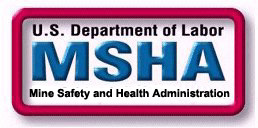
Mine Safety and Health Administration
Protecting Miners' Safety and Health Since 1978

 |
U.S. Department of Labor Mine Safety and Health Administration Protecting Miners' Safety and Health Since 1978 |
 |
| www.msha.gov |
|
|

The potential hazards of welding operations include metal fumes, toxic gases, and ultraviolet and infrared radiation. Fume particles are formed from vaporization of molten metal. They are very fine in size, generally one micron or smaller, and may join together to form larger particles. Fumes can be sampled by drawing air through a special filter at a controlled rate. The adverse health effects of overexposure to welding fumes and gases include chronic or acute systemic poisoning, metal fume fever (a short-term painful ailment with symptoms of fever and chills), pneumoconiosis (lung disease due to accumulation of mineral or metallic particles), and irritation of the respiratory tract. The welding fumes produced at welding operations depend primarily on the composition of the metals being welded and the welding rods. When the base metal is iron or steel, with welding rods of similar composition the main component of the fume will be iron oxide. When welding on stainless steel, fumes containing nickel and chromium may be produced. Welding on plated, galvanized, or painted metals may generate fumes containing cadmium, zinc oxide, or lead. In addition, welding rods can generate fluoride in the fume as well as free silica, depending on the composition of the welding rod coating. In summary, welding processes may generate many different metal fumes and other toxic components. It is important that the hazards of a welding operation be evaluated properly. Toxic gases that arise in welding include carbon monoxide, nitrogen dioxides, and ozone. If welding or cutting operations are conducted in the presence of chlorinated hydrocarbons, such as the form of solvents either on the metals or in the air, hazardous concentrations of phosgene and hydrogen chloride, which are highly toxic irritant gases, may be produced. In addition to the health hazards of metal fumes and toxic gases, welding operations involve the hazard of burns from flame, arc, molten metal, and heated surfaces and also that of metal splatter. Welding operations in general require face, neck and eye protection for the welder -- against sparks, splatter of molten metal, and the radiations (ultraviolet, infrared, and intense visible) of the arc or flame. Normally this means that a welder will wear a welding hood, or helmet, though in some cases gas welding may properly be done with adequate goggles, gloves, and other protective clothing of neck and arms. When personal respiratory protection is required, this may be provided by a supplied-air welding hood or when the components and concentration of the fume are known, by a filter-type respirator with filter for protection against fumes. It is preferable, of course, that adequate ventilation be provided so as to make the use of respirators unnecessary. When sampling for welding fumes, the inspector will use a filter-cassette placed on the collar or shoulder so that it is beneath the helmet when the helmet is placed down. the sampling pump is fastened to the belt. Samples may be full shift or short-term. Short-term samples may be taken to evaluate toxic components which have short-term limits. In addition, the inspector may sample for toxic gases such as ozone, nitrogen oxides, or phosgene. It isimportant that the welder carry out the welding operation in a normal way, so that an accurate evaluation of the exposure can be made. The inspector will attach and remove the filter cassette and pump as required. Normally, good local or general ventilation is required to control exposures to the metal fumes and gases of welding operations. The most effective control is local exhaust ventilation in which an exhaust hood is placed near the welding arc or flame, and the contaminants are drawn away from the welder's breathing zone. The system may consist of moveable exhaust hoods, flexible and stationary ducts, a powered fan, and a fume or dust collector. Exhausted air should be discharged to the outdoors, if possible, it is important that, during the welding operation, the exhaust hoods are placed or set so that welding fumes are not drawn across the worker's face or into the breathing zone. Good general ventilation should be provided. Welding in confined spaces such as tanks, cabs of mobile equipment, and large shovels may be especially hazardous and requires additional ventilation. If you have any questions about this or any other occupational health matter, feel free to ask us. Our job is protecting your health.Contact: Mine Safety and Health Administration Metal and Nonmetal Health Division 1100 Wilson Boulevard Arlington, Virginia 22209-3939 Phone: (202) 693-9630 |
|
|
www.msha.gov | www.dol.gov |
|
| ||
|---|---|---|
|
| ||
|
Mine Safety and Health Administration (MSHA) 1100 Wilson Boulevard, 21st Floor Arlington, VA 22209-3939 |
Phone:
(202) 693-9400 Fax-on-demand: (202) 693-9401 Technical (web) questions: Webmaster On-line Filing Help: MSHAhelpdesk@dol.gov or call (877) 778-6055 Contact Us | |